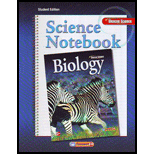
Concept explainers
To identify:
The echinoderm that moves in the described way by completing the given chart.
Introduction: Animals belonging to the phylum Echinodermata have unusual characteristics that distinguish them from animals of other phyla. These animals are found in all the oceans of the world. They move by means of hundreds of hydraulic, suction- cup- tipped appendages and have skin covered with tiny pincers.
Answer to Problem 7MI
| Echinoderm | Movement |
| Sea urchin | Burrows into rocky areas using movable spines |
| Brittle star | Makes snakelike movements using tube feet and arms |
| Feather star | Uses cirri to grasp soft sediments on the sea floor |
| Sea cucumber | Crawl using tube feet and body wall muscles |
Explanation of Solution
There are different classes of echinoderms; such as sea stars, brittle stars, sea urchins, sea lilies, sea cucumbers and sea daisies. All echinoderms have tube feet and endoskeletons bearing spines. Each class shows a different type of movement.
Burrowing is a characteristic of sea urchins. They burrow into rocky areas with the help of their sharp, movable spines.
Brittle stars have five arms but lack suckers on their tube feet. So they cannot use them for movement. They move by rowing themselves quickly over the bottom rocks and sediments or by snakelike movements of their arms.
A feather star extends its arms from a central point where they are attached. They capture food by extending their tube feet and arms into water where they catch suspended organic materials.
Sea cucumbers move sluggishly by means of tube feet helped by contractions in their muscular body wall.
Additional Science Textbook Solutions
Fundamentals of Anatomy & Physiology Plus Mastering A&P with eText - Access Card Package (10th Edition) (New A&P Titles by Ric Martini and Judi Nath)
Biological Science
Study Guide for Campbell Biology
Campbell Essential Biology with Physiology (6th Edition)
Campbell Biology: Concepts & Connections (8th Edition)
Laboratory Experiments in Microbiology (11th Edition)
 Human Anatomy & Physiology (11th Edition)BiologyISBN:9780134580999Author:Elaine N. Marieb, Katja N. HoehnPublisher:PEARSON
Human Anatomy & Physiology (11th Edition)BiologyISBN:9780134580999Author:Elaine N. Marieb, Katja N. HoehnPublisher:PEARSON Biology 2eBiologyISBN:9781947172517Author:Matthew Douglas, Jung Choi, Mary Ann ClarkPublisher:OpenStax
Biology 2eBiologyISBN:9781947172517Author:Matthew Douglas, Jung Choi, Mary Ann ClarkPublisher:OpenStax Anatomy & PhysiologyBiologyISBN:9781259398629Author:McKinley, Michael P., O'loughlin, Valerie Dean, Bidle, Theresa StouterPublisher:Mcgraw Hill Education,
Anatomy & PhysiologyBiologyISBN:9781259398629Author:McKinley, Michael P., O'loughlin, Valerie Dean, Bidle, Theresa StouterPublisher:Mcgraw Hill Education, Molecular Biology of the Cell (Sixth Edition)BiologyISBN:9780815344322Author:Bruce Alberts, Alexander D. Johnson, Julian Lewis, David Morgan, Martin Raff, Keith Roberts, Peter WalterPublisher:W. W. Norton & Company
Molecular Biology of the Cell (Sixth Edition)BiologyISBN:9780815344322Author:Bruce Alberts, Alexander D. Johnson, Julian Lewis, David Morgan, Martin Raff, Keith Roberts, Peter WalterPublisher:W. W. Norton & Company Laboratory Manual For Human Anatomy & PhysiologyBiologyISBN:9781260159363Author:Martin, Terry R., Prentice-craver, CynthiaPublisher:McGraw-Hill Publishing Co.
Laboratory Manual For Human Anatomy & PhysiologyBiologyISBN:9781260159363Author:Martin, Terry R., Prentice-craver, CynthiaPublisher:McGraw-Hill Publishing Co. Inquiry Into Life (16th Edition)BiologyISBN:9781260231700Author:Sylvia S. Mader, Michael WindelspechtPublisher:McGraw Hill Education
Inquiry Into Life (16th Edition)BiologyISBN:9781260231700Author:Sylvia S. Mader, Michael WindelspechtPublisher:McGraw Hill Education





